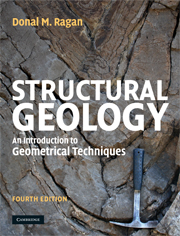Book contents
- Frontmatter
- Contents
- Preface
- Acknowledgements
- 1 Structural planes
- 2 Thickness and depth
- 3 Lines and intersecting planes
- 4 Planes and topography
- 5 Stereographic projection
- 6 Rotations
- 7 Vectors
- 8 Faults
- 9 Stress
- 10 Faulting
- 11 Deformation
- 12 Strain
- 13 Flow
- 14 Folds
- 15 Parallel folds
- 16 Similar folds
- 17 Folds and topography
- 18 Structural analysis
- 19 Tectonites
- 20 Drill hole data
- 21 Maps and cross sections
- 22 Block diagrams
- Appendices
- References
- Index
4 - Planes and topography
Published online by Cambridge University Press: 05 June 2012
- Frontmatter
- Contents
- Preface
- Acknowledgements
- 1 Structural planes
- 2 Thickness and depth
- 3 Lines and intersecting planes
- 4 Planes and topography
- 5 Stereographic projection
- 6 Rotations
- 7 Vectors
- 8 Faults
- 9 Stress
- 10 Faulting
- 11 Deformation
- 12 Strain
- 13 Flow
- 14 Folds
- 15 Parallel folds
- 16 Similar folds
- 17 Folds and topography
- 18 Structural analysis
- 19 Tectonites
- 20 Drill hole data
- 21 Maps and cross sections
- 22 Block diagrams
- Appendices
- References
- Index
Summary
Exposures on horizontal surfaces
In Chapter 2 the simplest examples of the determination of thickness assumed that the earth's surface was a horizontal, geometrically perfect plane. The intersection of inclined layers with this surface results in an outcrop pattern. Represented in map view this pattern is a simple geological map.
In this case the width of the outcrop bands depends on two factors: the actual thickness of the layers and the angle of dip of each layer. The separate effect of each of these factors is shown in Fig. 4.1. In essence, these same relationships also apply to less-than-perfect real horizontal topographic surfaces.
In the special case of a vertical layer, the outcrop width in map view is equal to the thickness of the layer. This unique relationship results from the fact that the map shows such a layer in edge view, that is, a line of sight in viewing the map coincides with a line which is parallel to the vertical layer. In estimating thickness of tabular objects, one instinctively seeks just such a view.
In the more general case of an inclined layer, one line of sight is always identifiable on a geological map; it is in the dip direction. For inclined layers an auxiliary view perpendicular to this line could easily be constructed that would show the layers in edge view and therefore in true thickness (Fig. 4.2a).
- Type
- Chapter
- Information
- Structural GeologyAn Introduction to Geometrical Techniques, pp. 72 - 87Publisher: Cambridge University PressPrint publication year: 2009



